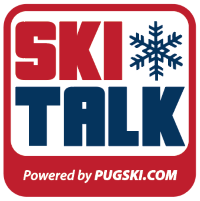Exactly.
That's why I made the posting. As a former collegiate athlete (track & field) -- where mechanics and execution were paramount to me -- I tend to ask a lot of questions. When people say you need to turn in the shapes of C and S, to me, that's an outcome or output. I want to know what are the inputs, the how, and the steps to execute -- I think I'm getting there, albeit slower than I had hoped.
OK, I'll play. You want to know how to make C-shaped turns, instead of Z-shaped turns?
First, watch this video:
It describes C-shaped turns. There are two lines, the line the center of mass travels, and the line the feet travel. One line is longer, that's the line along which the feet travel. That's the C-shaped line you are asking about. The other line is shorter. It's the one the center of mass travels. For simplicity, think of the center of mass as the center (ish) of your torso.
Notice that the CoM line and the ski line criss-cross each other. This is the critical point in a C-shaped turn that you want to make happen.
Technique wise, you will need to learn how to get your center of mass to cross over the skis to their downhill side. Or, alternatively, you will need to learn how to get your skis to cross up under your center of mass, which by default also results in the center of mass being on the downhill side of the skis.
While you are busy doing this criss-cross thing, your skis/feet will need to travel across the hill - pointing more-or-less at the trees - for a bit. After the switcheroo happens, you must make sure your skis progressively (slo-mo if necessary) turn to point downhill. Do not quickly pivot them; that makes a Z-shaped turn. This is probably what you are currently doing.
The skis may be flattish after the switch if your CoM doesn't completely get on the downhill side of the skis, or they may be on their new downhill edges if it does. That's the goal, anyway. Which happens (flattish or on new edges at the top of the turn) depends on how you get the cross-over or cross-under to happen.
In any event, your turns will as a result have a top to them. They won't be Z-shaped any more. The tops won't be rushed nor cut off. The turns will be completed (aka finished), and they will be C-shaped. Because your skis spent time going across the hill, you'll have extra speed control... so yes, one can add speed control at the top of the turn. If you successfully get skis onto new edges above the fall line, your skis will grip better below it. So there's even more speed control available at the bottom of the turn (especially on hard snow), instead of having the skis skid downhill out of control downhill at the end of the Z-turns.
You'll need an instructor to teach you how to initiate C-shaped turns. People can actually get ideological about how to do this and argue. Get ready for the fun.

